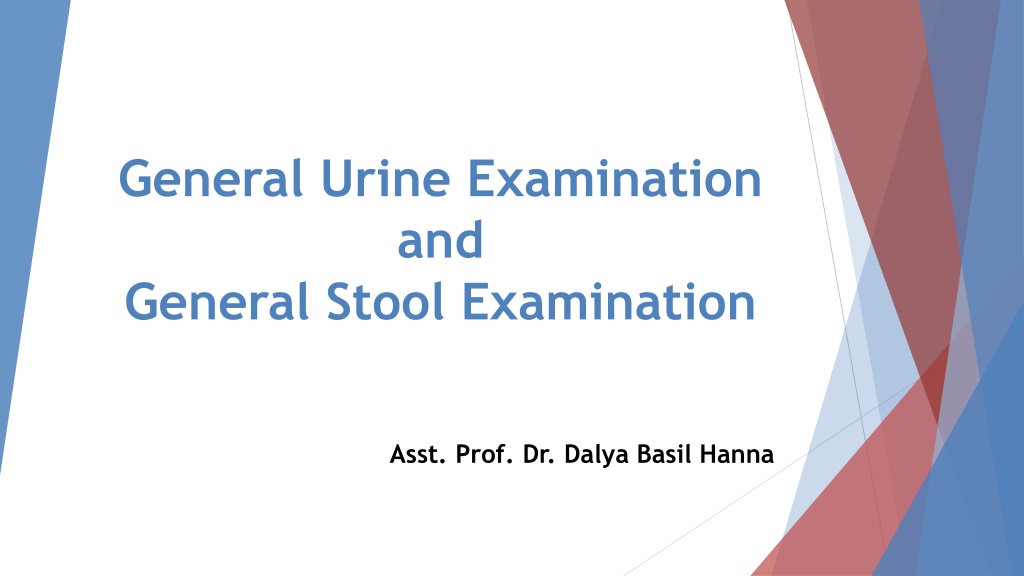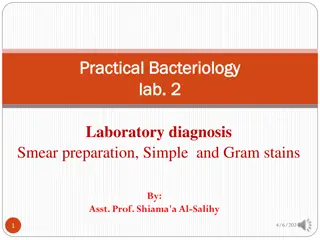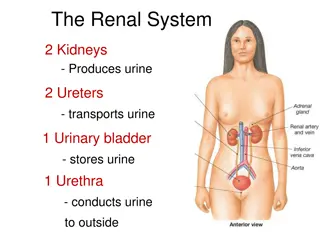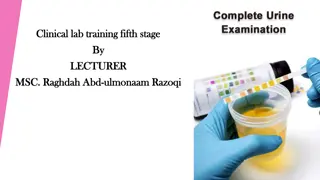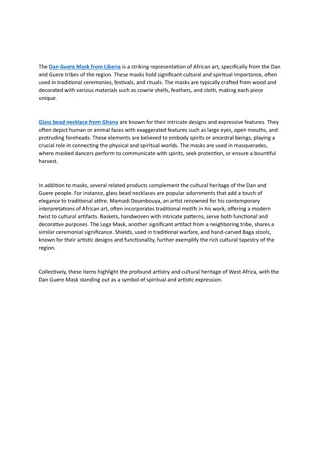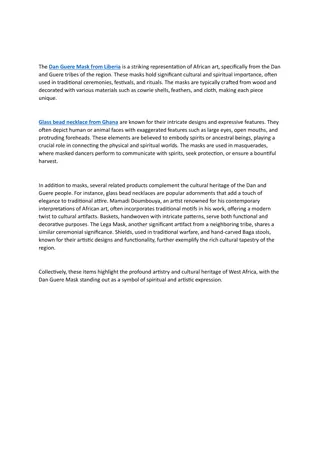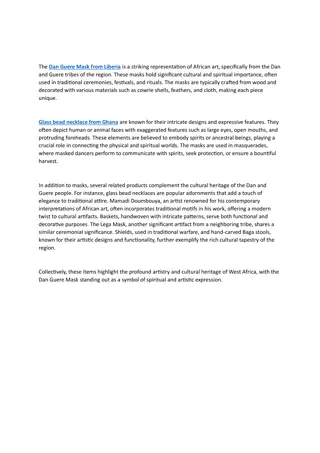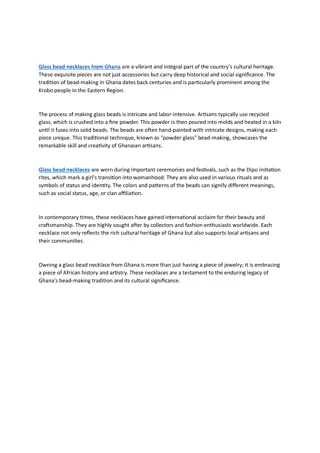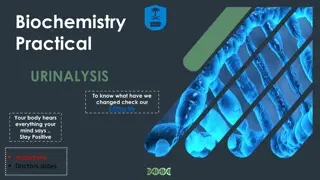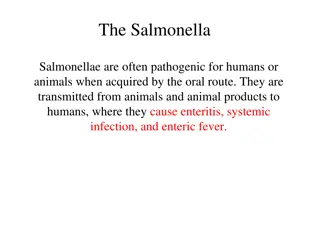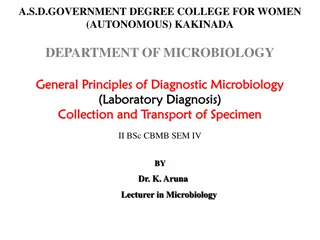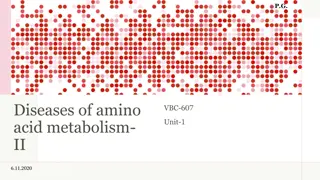Understanding General Urine Examination and Stool Examination
General urine examination involves analyzing the color, clarity, and chemical composition of urine, providing insights into various health conditions and potential issues. It helps in detecting metabolic disorders, kidney diseases, and drug abuse. Additionally, the general stool examination is essential for evaluating digestive health. Both examinations are crucial diagnostic tools used by healthcare professionals to assess a patient's overall well-being.
Download Presentation

Please find below an Image/Link to download the presentation.
The content on the website is provided AS IS for your information and personal use only. It may not be sold, licensed, or shared on other websites without obtaining consent from the author. Download presentation by click this link. If you encounter any issues during the download, it is possible that the publisher has removed the file from their server.
E N D
Presentation Transcript
General Urine Examination and General Stool Examination Asst. Prof. Dr. Dalya Basil Hanna
Urine analysis Urine is a liquid mainly consisting of water and waste products of our body, generated through filtering the blood by the kidneys. Urine contains residual nitrogen substances such as urea, uric acid, creatinine and a small dose of mineral salts and enzymes. Among these the urochrome, which is the pigment that gives urine the typical amber yellow color. Bilirubin and urobilin also make the urine yellow. substances, there is also
Urine analysis Urine analysis: is the term used to refer to the test used to evaluate a urine sample. Because urine removes liquids from the body, its contents can provide vital health information. Obvious abnormalities in the color, clarity, and cloudiness may suggest different diseases, such as metabolic disorders and kidney disease. Urinalysis can also be used to uncover evidence of drug abuse. toxins and excess
Urinalysis Basics Urinalysis consists of the following: Macroscopic Examination Chemical Analysis Microscopic Examination
Macroscopic Examination Observing the physical properties of the urine: Color: Normal urine should be a shade of yellow ranging from a straw to amber color. Normal urine volume is 750 to 2000 ml/24hr. Abnormal urine can be: colorless, dark yellow, orange, pink, red, green, brown, or black. Clarity (transparency): Normal urine should be clear Abnormal urine can be: hazy, cloudy, or turbid
Macroscopic Examination Pale straw color: Normal, healthy, well-hydrated. Transparent: Colorless urine may indicate over-hydration which can dilute essential salts, such as electrolytes, creating a chemical imbalance in the blood. Transparent yellow: Normal. Dark yellow: Normal, but suggestive of mild dehydration. Amber or honey: Possibly dehydrated. Light orange: Possibly dehydrated, but may also be caused by liver or bile duct problems. Orange: Some medications, such as rifampin or phenazopyridine, can cause this coloration.
Macroscopic Examination Red: This color could be a worrisome sign of many things. Blood in the urine, called hematuria, idiopathic or a sign of a kidney stone, infection or tumor in the urinary tract. It may signal a problem with the prostate. Or a group of as porphyrias. rare inherited disorders known Blue: Some medications and food dyes produce bluish urine. So too does a rare inherited metabolic hypercalcemi or blue diaper syndrome, which is characterized by incomplete intestinal breakdown of tryptophan, a dietary nutrient. disorder known as familial Dark brown or black: Some medications darken urine. Copper or phenol poisoning or melanoma, can result in blackish urine called melanuria. White or milky: This may be caused by an overabundance of certain minerals, such as calcium or phosphate, a urinary tract infection or excessive proteins.
Chemical Analysis The chemical properties of urine, including pH, specific gravity, protein content, glucose content, ketone content, and others are tested. pH Test measures if urine is acidic, basic or neutral Normal urine ranges from 4.6 to 8.0 Specific Gravity: Test measures the concentration of particles in the urine and evaluates the body s water balance. The more concentrated the urine, the higher the urine specific gravity. The most common increase in urine specific gravity is the result of dehydration. Normal urine ranges between 1.002 to 1.028
Chemical Analysis Ketones: Test measures the presence or absence of ketones, the endpoint of rapid or excessive fat breakdown, in the urine. Normal urine does not contain ketones Protein: Normal urine levels of proteins (called albumin) are very small, usually approximately 0 to 8 mg/dl. Glucose: The test measures the amount of sugar in a urine sample. Normal urine does not contain glucose.
Chemical Analysis (Urine test strips) A standard urine test strip may comprise up to 10 different chemical pads or reagents which react (change color) when immersed in, and then removed from, a urine sample. The test can often be read in as little as 60 to 120 seconds after dipping. Routine testing of the urine with multiparameter strips is the first step in the diagnosis of a wide range of diseases. The analysis includes of proteins, glucose, ketones, haemoglobin, bilirubin, uro bilinogen, acetone, nitrite and leucocytes as well as testing of pH and specific gravity or to test for infection by different pathogens. testing for the presence
http://1.bp.blogspot.com/-UVhhcgbhfqw/UE4X8rS2v5I/AAAAAAAAB4E/1CFxx2jJ38k/s640/UroTest+Table.pnghttp://1.bp.blogspot.com/-UVhhcgbhfqw/UE4X8rS2v5I/AAAAAAAAB4E/1CFxx2jJ38k/s640/UroTest+Table.png Chemical Analysis
Microscopic Examination In microscopy, a sample of urine is centrifuged to obtain some sediment, a variety of normal and abnormal cellular elements may be seen in urine when looked at under a microscope, including: Red blood cells White blood cells Epithelial cells Crystals Bacteria
Microscopic Examination Red Blood Cells: Hematuria is the presence of abnormal numbers of red cells in urine due to: a. Glomerular damage b. Tumors c. Urinary tract stones d. Upper and lower urinary tract infections
Microscopic Examination Two Types of Hematuria Gross hematuria means that the blood can be seen by the naked eye. The urine may look pinkish, brownish, or bright red. Microscopic hematuria means that the urine is clear, but blood cells can be seen under a microscope.
Microscopic Examination White blood cells: Pyuria refers to the presence of abnormal numbers of leukocytes that may appear with infection in either the upper or lower urinary tract or with acute glomerulonephritis. WBCs - 2-5 WBCs/hpf
Microscopic Examination Epithelial cells: Renal tubular epithelial cells, contain a large round or oval nucleus and normally slough into the urine in small numbers. syndrome and in conditions degeneration, the number sloughed is increased. However, with nephrotic tubular leading to Normal range: 15-20 squamous epithelial cells/hpf
Microscopic Examination Urinary casts may be made up of cells (such as white blood cells, red blood cells, kidney cells) or substances such as protein. Hyaline casts are composed primarily of a mucoprotein (Tamm-Horsfall proteins) secreted by tubule cells.
Microscopic Examination Bence Jones proteins are small proteins found in the urine. Testing for these proteins is done to diagnose and monitor multiple myeloma and other similar diseases. Bence Jones proteins are considered the first tumor marker. A tumor marker is a substance, made by the body, that is linked to a certain cancer, or malignancy. Bence Jones proteins (myeloma casts) are made by plasma cells, a type of white blood cell. The presence of these proteins in a person's urine is associated with a malignancy of plasma cells.
General Stool Examination A stool analysis is a test on a stool (feces) sample to help diagnose certain conditions affecting the digestive tract. Collection of Fecal Specimens: Collect about 10-15 gm the stool in a dry, clean, container. Make sure no urine, water, soil or other material gets in the container. If it is not possible to obtain feces collect a specimen by inserting a cotton wool swab into rectum for about 10 sec. Label the specimen with the patient s name, date and time of collection and send it with a request form to reach laboratory as soon as possible. Fresh stool should be examined immediately, or preserved .
General Stool Examination Direct saline wet mount Place a drop of saline on the slide. Pick up a small amount of fecal material on the end of an applicator stick. Emulsify in the saline and cover with a cover slip. Examine on low and high power. entire preparation presence of eggs, larvae and protozoa. The must be examined for the Note: Take small amounts of material from several different areas (stool surface and deep inside), especially from bloody and/or mucoid areas.
Stool analysis Basics Stool analysis consists of the following: Macroscopic (Physical) Examination Chemical Analysis Microscopic Examination
Macroscopic (Physical) Examination 1- The color of stool 2- Odor 3- Consistency of stool 4- Naked eye parasite 5- Gross blood 6- Mucus
Macroscopic (Physical) Examination Normal color of stool is brown. The characteristic brown color of feces is due to stercobilin and urobinin, both of which are produced by bacterial degradation of bilirubin. Abnormal color: Black color: indicate iron medication (for treatment of anemia ) or upper GIT bleeding (due to peptic ulcer or stomach carcinoma). - Bright red color (Hematochezia): indicate lower GIT bleeding (due to anal fissure). - Pale brown color: with a greasy consistency indicate pancreatic deficiency causing malabsorption of fat (often with offensive odor). - Yellow-green color: occurs in the stool of breast-fed infants who lack normal intestinal flora (low bile conversion) and may also occurs due to rapid transit of feces through the intestines. - Red brown color: indicate drugs as Tetracyclines, and Rifambicin antibiotics. -
Macroscopic (Physical) Examination Normal odor of stool is offensive results from gases produced by bacterial metabolism, including skatole, mercaptans, indole and hydrogen sulfide formed by bacterial fermentation and putrefaction. Abnormal odor is Very offensive: usually seen in cases of constipation and with certain types of food that produce excessive gases, Bacterial infection and malabsorption. - Consistency: Normally well formed Abnormal: Very hard: seen in cases of constipation - Semi formed: seen in the cases of parasitic infection - Soft: seen in the cases of parasitic infection - Loose: seen in the cases of diarrhea - Watery: mostly seen in cases of bacterial infection -
Macroscopic (Physical) Examination Naked eye parasite : Normal: no parasites or larva appear in the stool but in some cause the whole worm or part of its body appear in the stool and can be seen by naked eye like(segment of tap worm ) Two worms can be seen by naked eye in the stool: - Ascaris lumbericoides and Entrobius vermicularis - Gross blood: Normally no blood seen in the stool. Abnormal fresh blood (Hematochezia) seen in cases of lower GIT bleeding and also known as "bright red blood per rectum" and abbreviated BRBPR -
Macroscopic (Physical) Examination Mucus: Normally undetectable amount produce by GIT and found in the stool. Abnormal mucus in the sample appears as white patches and according to the amount of mucus it can be graded using signs (+, ++, +++). - Mucus abnormally can be found in the stool in the following cases: Spastic colon (translucent mucus on the surface of stool) Ulcerative colitis Bacillary dysentery (mucus with fresh pus) Amoebic dysentery (mucus with fresh blood)
Chemical Analysis pH is Normally variable and diet dependent and is based on bacterial fermentation in the small intestine. High alkaline stool- Physiological: cause by using High protein diet Pathological : Colitis or Antibiotic use (impaired colonic fermentation) High acidic stool- Physiological :High carbohydrate diet Pathological: Poor fat absorption - - - - Fat in stool: Increased Fats is associated with Malabsorption Syndromes, such as Coeliac disease, Crohn s disease, Enteritis and Pancreatic diseases, Surgical Intestine, and others. removal of section of
Chemical Analysis Faecal occult blood test (FOBT): Detect blood which is present in amount or form not visible macroscopically. When the bleeding is chronic with only small amounts of blood being passed in the feces, the blood (or its breakdown products) is not recognized in the feces and is referred to as occult (hidden) blood. An average, healthy person passes up to 2.0 mL of blood per 150 g of stool into the GIT daily. Passage of more than 2.0 mL of blood in the stool in 24 hours is pathologically significant.
Chemical Analysis BENZIDINE TEST, GUAIAC TEST, and ORTHOTOLIDINE TEST are used in FOBT Principle of the test: The principle of chemical tests to detect occult blood is based on the fact that hemoglobin and its derivatives react in a similar way to peroxidase enzymes by catalyzing the transfer of an oxygen atom from the peroxide to a chromogen such as benzidine, o- toludine, guaiac or aminophenazone. Oxidation of the chromogen is indicated by the production of a blue, blue-green or pink color.
Microscopic Examination The microscopic examination may be used to determine the presence of leukocytes and erythrocytes in a fecal smear. This will very quickly give the clinician information on the patients disease state. Determination of the presence of leukocytes may be useful in the diagnosis of patients with diarrhea due to bacterial infection. Microscopic examination of stool can be done by Gram stain, Wrights Stain, and by wet mount procedure.
Microscopic Examination For the diagnosis of microscopic elements: Trophozoites and its movements are better seen in unstained preparation of a fresh material. Cystic forms &Nuclear character are better seen in stained preparation(iodine) Gycogen mass- stained with iodine Chromatoid bars- unstained preparation N.B Both stained and unstained materials are to be prepared
Microscopic Examination Procedure for the microscopic examination of faecal samples for parasites 1. place a drop of saline a clean slide. 2. place a small piece of stool on the slide and mix with saline, cover with a cover slip. If the specimen contain mucus, the examination prefer to be done without saline. The mucus is put on the slide and covered with cover slip. 3. examine under 10X and 40X objectives. Using of Saline: Normal saline (0.85%) is used for routine examination of stool samples, as it is isotonic. Using of Iodine: Iodine is used to examine the nuclei of cysts. Using of Eosin 1%: this provide a pink background and that will help to clear the unstained objects.
References Urinalysis: Part 1. 2006 The University of Iowa (accessed 17 Aug 2007) Available from: http://www.medicine.uiowa.edu/cme/clia/modules.asp?testID=19 http://www.utmem.edu/nephrology/documents/powerpoint-urinalysis- files/frame.htm http://www.texascollaborative.org/spencer_urinalysis/ds_overview.htm http://www.nlm.nih.gov/medlineplus/ency/article/003583.htm http://www.nlm.nih.gov/medlineplus/ency/article/003587.htm http://www.medicineplus.com
